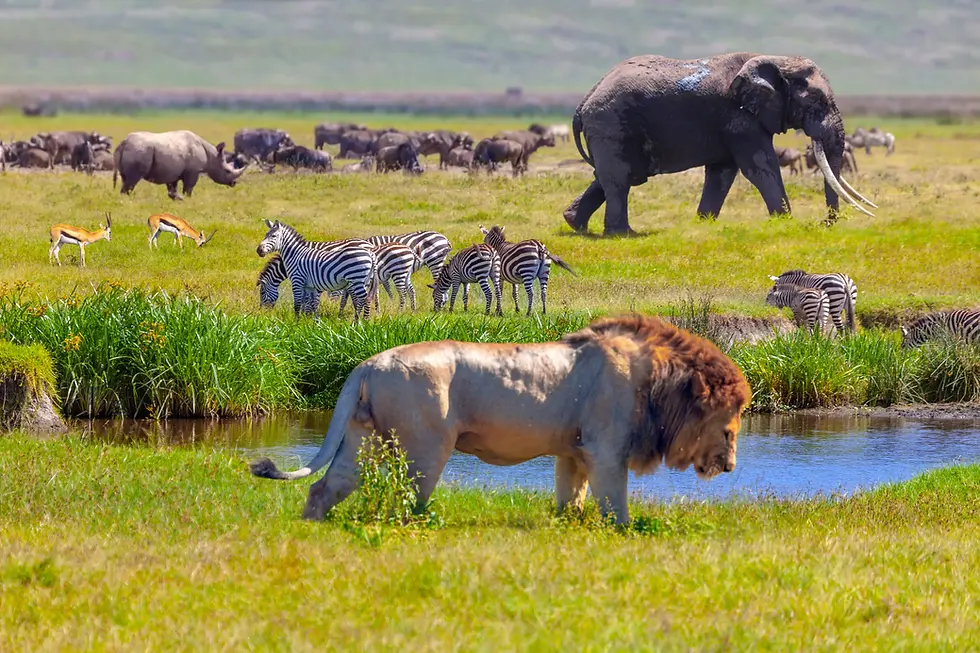The Silent Crisis: Threats to Wildlife and Their Habitats
- Yosna Venkatesh
- Apr 22
- 2 min read
Picture a lush rainforest abounding with life, birds chirping, monkeys swinging, jaguars prowling. Now, imagine it barren, stripped of life. This is the grim reality of today. Wildlife faces mounting threats, leading to a severe decline in biodiversity. If unchecked, this crisis will disrupt nature’s balance, impacting ecosystems and humanity alike.
Major Threats to Wildlife
Habitat Destruction
As human populations grow, forests, wetlands, and grasslands are cleared for development and farming, breaking up habitats and leaving species isolated. Deforestation wipes out millions of hectares each year, putting species like orangutans and Bengal tigers at risk while speeding up climate change.
Pollution
Plastic waste, chemical runoff, and air pollution pollute ecosystems, endangering wildlife. Mercury from gold mining seeps into waterways, poisoning aquatic life and disrupting food chains. Meanwhile, neurotoxic pollutants weaken animals’ ability to survive, putting biodiversity at even greater risk.
Climate Change
Rising temperatures and extreme weather are pushing species toward extinction. The North Atlantic right whale struggles with food shortages as oceans warm, while Hawaiian birds migrate to avoid disease. As the climate changes, more species will be forced from their habitats.
Poaching & Illegal Wildlife Trade
Wildlife trafficking drives species toward extinction, as elephants are killed for ivory and pangolins for their scales. The loss of keystone species disrupts ecosystems, yet the illegal trade continues, fueled by demand for exotic pets and traditional medicine.
Human-Wildlife Conflict
Encroaching settlements increase clashes. In Kenya, elephants raid crops, prompting farmers to retaliate. Without sustainable solutions, such conflicts threaten both humans and wildlife.
Urban Wildlife Challenges
Urban wildlife faces distinct challenges, from millions of birds dying in window collisions to poisons harming animals indiscriminately and roads blocking natural movement. Solutions like wildlife corridors and bird-safe buildings provide hope for their survival.
Agriculture & Biodiversity Loss
Farming contributes to habitat destruction, pollution, and climate change, with runoff creating ocean dead zones like in the Gulf of Mexico. However, the Black Sea’s recovery shows that restoration is possible through sustainable practices.
Why This Matters
The loss of wildlife is more than just an environmental concern, it directly impacts human survival. Ecosystems provide vital services such as pollination and climate regulation. Protecting biodiversity ensures the well-being of both nature and humanity.
How Can We Help?
Individual Actions:
Raise Awareness: Educate others about conservation.
Support Conservation Efforts: Donate to wildlife organizations.
Choose Sustainable Products: Avoid palm oil, reduce plastic use.
Advocate for Change: Push for stronger environmental laws.
Institutional Actions:
Enforce Legal Protections: Strengthen anti-poaching laws.
Fund Research: Support studies on climate resilience and conservation.
Implement Sustainable Planning: Develop green spaces and wildlife corridors.
Foster Global Cooperation: Unite governments, NGOs, and communities.
A Future for Wildlife
Wildlife is under immense pressure, but we have the power to reverse the damage. By adopting sustainable practices and strengthening conservation efforts, we can safeguard biodiversity. The decision is ours, will we take action or stand by as species disappear?
Work Cited
Baines, Holly. “What Are Some of the Biggest Threats to Wildlife?” Animal Charity Evaluators, 25 Mar. 2024, animalcharityevaluators.org/blog/threats-to-wildlife/?gad_source=1&gclid=Cj0KCQjw16O_BhDNARIsAC3i2GDQaaDAv8cO3ytaeTAl6PebZLjSjW4_KyRoj5ITnkdoZX936uh9g4IaArnBEALw_wcB.
“Titre Threats to Wildlife.” THREATS TO WILDLIFE | Palmyre Conservation, www.palmyre-conservation.org/en/threats-to-wildlife. Accessed 1 Apr. 2025.




Comments